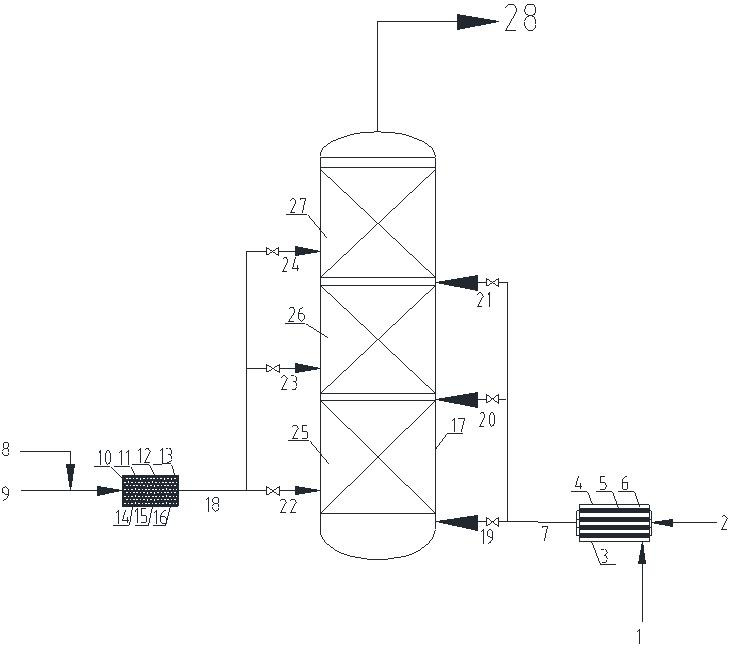Olefin hydration process
A technology of olefin hydration and process, applied in the direction of hydroxyl addition preparation, organic chemistry, chemical instruments and methods, etc., can solve the problems of low miscibility, low reaction rate, long residence time, etc.
- Summary
- Abstract
- Description
- Claims
- Application Information
AI Technical Summary
Problems solved by technology
Method used
Image
Examples
Embodiment 1
[0047] Using the n-butene in Table 1 as raw material, the hydration reaction of n-butene with water under the action of a catalyst was used to prepare sec-butanol. The olefin hydration reactor is provided with a catalyst bed. Olefin and water are introduced into the inorganic membrane mixer with a water-ene mass ratio of 5.5:1 to form a mixed feed I, and the mixed feed I is introduced from the lower part of the first catalyst bed; the water-ene mass ratio is 1:4 The ratio is introduced into the microchannel mixing device to form the mixed feed II, and the mixed feed II is introduced from the lower part of the catalyst bed. Feed I is used as the main reaction feed, and Feed II is used as the feed to enhance the mass transfer reaction, so as to maintain high-efficiency mass transfer throughout the reaction process, improve the single-pass conversion rate of olefin hydration reaction, and reduce the ratio of water to ene. The reaction effluent leaves the reactor and enters the n...
Embodiment 2
[0054] Using the n-butene in Table 1 as raw material, the hydration reaction of n-butene with water under the action of a catalyst was used to prepare sec-butanol. The olefin hydration reactor is equipped with 3 catalyst beds. The mixed feed of olefin and water is introduced into the inorganic membrane mixer with the mass ratio of water to olefin of 9:1 to form the mixed feed I, and the mixed feed I is divided into three streams, which are respectively introduced from the lower part of the first, second and third catalyst beds. ; The water-ene mass ratio is introduced into the microchannel mixing device in a ratio of 1:8 to form a mixed feed II, and the mixed feed II is divided into two streams, which are respectively introduced from the middle and lower parts of the second and third catalyst beds. Feed I is used as the main reaction feed, and Feed II is used as the feed to enhance the mass transfer reaction, so as to maintain high-efficiency mass transfer throughout the react...
Embodiment 3
[0060] Using the n-butene in Table 1 as raw material, the hydration reaction of n-butene with water under the action of a catalyst was used to prepare sec-butanol. The olefin hydration reactor is equipped with 3 catalyst beds. Introduce olefins and water into an inorganic membrane mixer with a water-to-olefin mass ratio of 8.5:1 to form a mixed feed I, divide the mixed feed I into three strands, and introduce them from the lower part of the first, second, and third catalyst beds respectively ; The water-ene mass ratio is introduced into the microchannel mixing device in a ratio of 1:6 to form a mixed feed II, and the mixed feed II is divided into three strands, which are respectively introduced from the lower part of the first, second, and third catalyst beds. Feed I is used as the main reaction feed, and Feed II is used as the feed to enhance the mass transfer reaction, so as to maintain high-efficiency mass transfer throughout the reaction process, improve the single-pass co...
PUM
| Property | Measurement | Unit |
|---|---|---|
| thickness | aaaaa | aaaaa |
Abstract
Description
Claims
Application Information
 Login to View More
Login to View More - R&D Engineer
- R&D Manager
- IP Professional
- Industry Leading Data Capabilities
- Powerful AI technology
- Patent DNA Extraction
Browse by: Latest US Patents, China's latest patents, Technical Efficacy Thesaurus, Application Domain, Technology Topic, Popular Technical Reports.
© 2024 PatSnap. All rights reserved.Legal|Privacy policy|Modern Slavery Act Transparency Statement|Sitemap|About US| Contact US: help@patsnap.com










